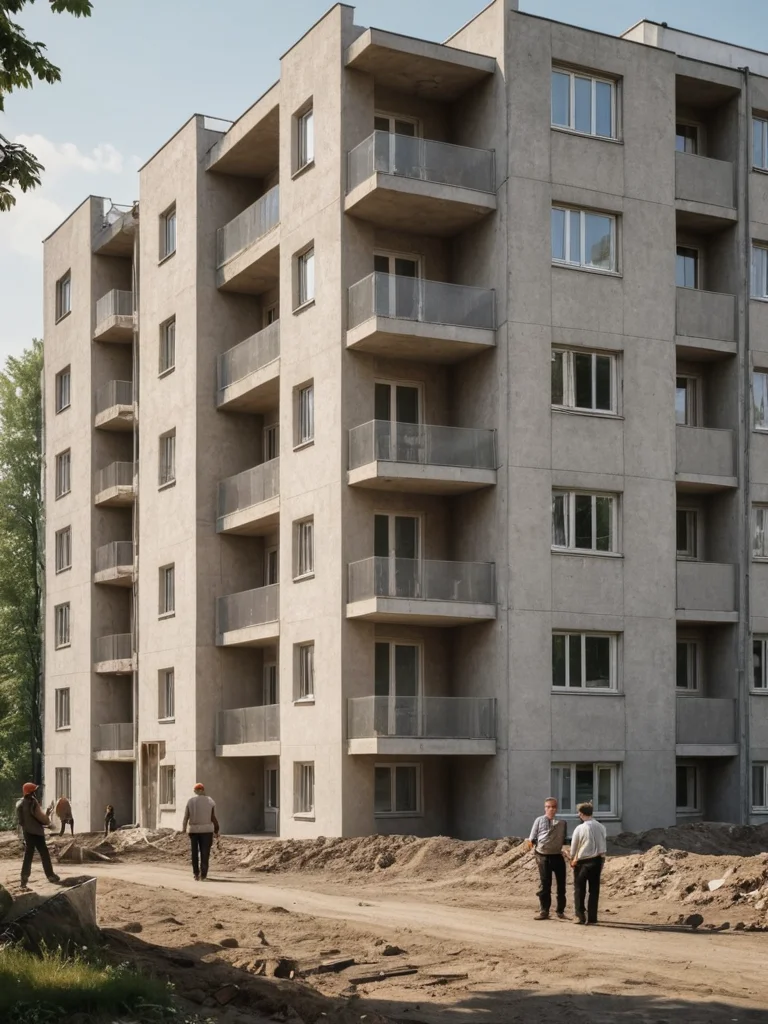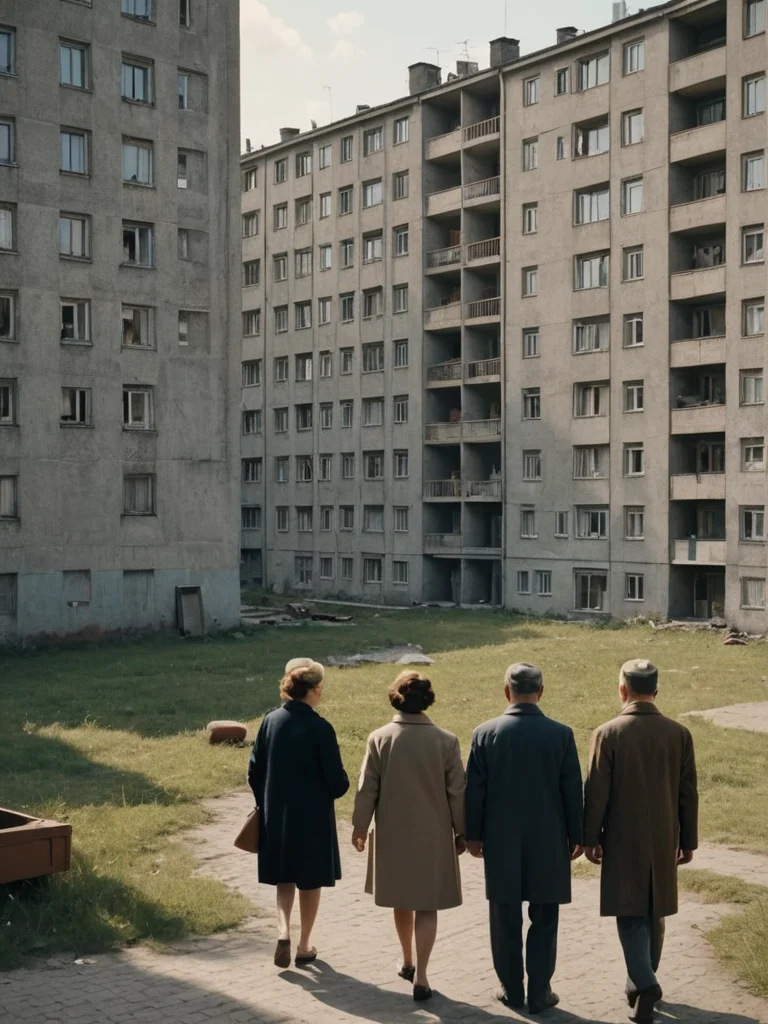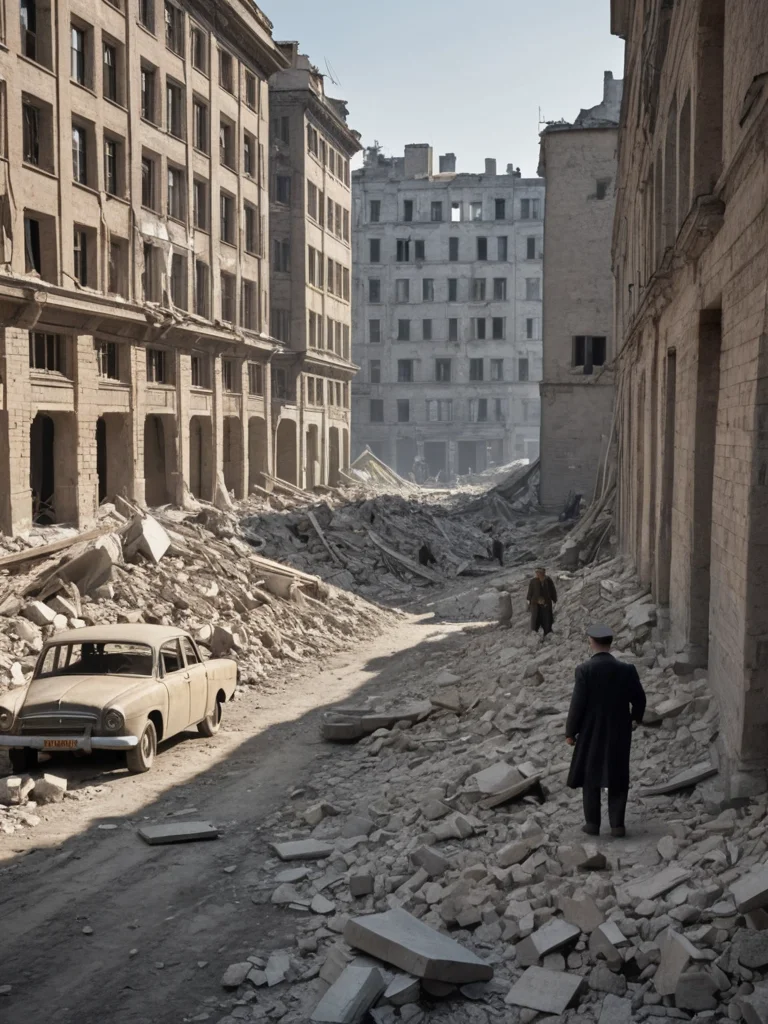The Great Patriotic War, which ended with Victory in May 1945, left a deep, indelible mark on the body and soul of the Soviet Union. The country lay in ruins, the destruction was colossal: hundreds of cities and thousands of villages turned to ash, industry was destroyed, millions of lives were lost. However, despite these unimaginable losses, the spirit of the people was not broken, but filled with an unprecedented determination to restore the state and build a new, peaceful life. It was in this context, against the backdrop of heroic labor and immense hardship, that post-war life was formed, which for many years determined the way of life for millions of Soviet citizens.
Life After Victory: What Daily Life Was Like in a Devastated, Yet Rebuilding USSR
Historians note that the first post-war years were perhaps some of the most difficult in the history of the USSR. The scale of destruction was truly catastrophic. From Stalingrad to Brest, from Leningrad to Sevastopol – cities were turned into ruins, factories lay in rubble, the transport system was paralyzed. Millions of people were left homeless. By the most conservative estimates, about 25 million people were forced to live in dugouts, barracks, destroyed buildings, or overcrowded apartments of others.
The demographic situation was also extremely difficult. The country lost millions of young men, which led to a significant gender imbalance and a huge burden on women, who now had to not only raise children but also take on the main burden of reconstruction work. A shortage of labor was felt everywhere, but at the same time, labor enthusiasm was astonishing. People worked literally to exhaustion, often without days off, for minimal pay or by labor days, guided by a common desire to lift the country out of ruins.
Economic difficulties were exacerbated by the famine of 1946–1947, caused by drought and the continued devastation of agriculture. The rationing system was in effect until the end of 1947, and its abolition was accompanied by a monetary reform that devalued the savings of many citizens, although it stabilized the financial system. There was a chronic shortage of food and essential goods. The black market flourished in the markets, where one could get anything, but at exorbitant prices.
Despite all these hardships, a special atmosphere prevailed in society – a mixture of fatigue and unprecedented uplift. The victory in the war filled people’s hearts with pride and faith in the future. State propaganda actively cultivated the image of the “victor,” calling for new labor feats. The cult of Victory was formed, which for many years became the cornerstone of Soviet identity. People who had endured unimaginable trials were ready to continue fighting – now for the restoration of peaceful life. During this period, collectivism, so characteristic of Soviet society, reached its peak, becoming not just an ideological postulate, but a vital necessity for survival and construction. Housing, its acute shortage, and the search for solutions to this problem became one of the central themes of the post-war period.
Communal Labyrinths: The Lives of Millions in One Apartment
The communal apartment, or as it was often called, the “kommunalka,” became one of the most recognizable symbols of Soviet daily life for decades. This phenomenon was not exclusively post-war – the first communal apartments appeared back in the 1920s as a result of the “densification” of bourgeois apartments after the revolution. However, it was precisely after the war, in conditions of an acute housing crisis, that communal apartments became home to millions of Soviet citizens, especially in large cities where the old housing stock was somehow preserved.
Imagine a former multi-room apartment of a pre-revolutionary merchant or official, which after nationalization was divided into separate “rooms” among several, and sometimes dozens, of families. Each family received one or two rooms, and the kitchen, bathroom, toilet, and hallway became shared. Life in such an apartment required special survival skills and the ability to constantly compromise. In essence, it was a model of society in miniature, where the fates and interests of completely different people intertwined.
Daily life in a communal apartment was filled with its own rituals and challenges. Mornings began with a queue for the shared toilet and bathroom, where often a single sink served several dozen people. Cooking in a shared kitchen turned into a complex logistical task. Each family had its own burner on a shared gas or wood stove, its own table, its own corner for storing dishes and food. Disputes often arose over space, dirty dishes, smells, or borrowed products without permission. Schedules for cleaning common areas were drawn up and often violated, which also became a cause of discord.
Privacy in a communal apartment was an ephemeral concept. Soundproofing was absent, and any quarrel, a child’s cry, or the operation of a radio set by one family was heard by all neighbors. On the one hand, this led to constant control and gossip, on the other hand, to the formation of unique social connections. Neighbors often knew more about each other than relatives, helped each other in trouble, and looked after children. However, this did not negate the constant tension associated with the need to share living space with strangers.
Historians and sociologists note that the communal apartment formed a special type of personality – a person accustomed to the lack of personal space, constantly in the public eye, but at the same time able to defend their boundaries. It was a place where the personal and the public constantly clashed, and domestic conflicts could escalate into dramatic stories. Despite all the difficulties, communal apartments became the only affordable housing for many, a symbol of the era, and an integral part of the cultural code of several generations of Soviet people.
From Cramped Spaces to Private Housing: The Khrushchev-era Building Revolution

By the mid-1950s, it became clear that communal apartments, despite their historical role, could not be a long-term solution to the housing problem. The Soviet leadership understood that the growth of well-being and the promises of communism required not just a roof over one’s head, but also certain standards of comfort and privacy. It was then, with Nikita Khrushchev coming to power, that a large-scale housing construction program was launched, which went down in history as the “Khrushchev Thaw” in the sphere of housing. The main slogan became: “A separate apartment for every family!”
This was a real revolution. The previous construction rates could not keep up with the needs of the population, and traditional building methods were too slow and expensive. The solution was found in the industrialization of construction. Instead of bricklaying, which required a lot of time and skilled labor, panel and large-block technologies were introduced. Ready-made concrete panels – walls, floors, staircases – were produced at factories, then delivered to construction sites and assembled like a construction set. This allowed entire neighborhoods to be built in a matter of months, significantly reducing costs and shortening deadlines.
The design of “Khrushchev-era buildings” was based on the principles of maximum functionality and space economy. The goal was to provide each family with a separate, albeit small, apartment. This meant abandoning the “excesses” inherent in Stalinist architecture with its high ceilings, stucco molding, and spacious rooms. Minimalism prevailed in “Khrushchev-era buildings”: ceilings became low (2.5 meters), kitchens – tiny (usually 5-6 square meters), bathrooms – combined. The “adjoining rooms” or “wagon” layout was common, where one room opened into another, which was also aimed at saving usable space and building materials.
Despite their apparent austerity, “Khrushchev-era buildings” were a breakthrough. They provided millions of Soviet families with the opportunity to finally acquire their own, separate housing. It was not just square meters, but a symbol of personal freedom, privacy, and a new stage in life. Construction was carried out on an unprecedented scale: by the early 1970s, over 100 million square meters of housing were commissioned annually in the USSR, allowing tens of millions of people to move out of communal apartments and barracks. This mass housing boom changed the face of Soviet cities and the way of life for entire generations.
Khrushchev-era Building vs. Communal Apartment: How Daily Life Changed

Moving from a communal apartment to a separate “Khrushchev-era building” was equivalent to moving to another civilization for many families. This change in living conditions radically altered daily life, affecting all aspects of life – from personal hygiene to family relationships and social dynamics. The main and perhaps most valuable acquisition was privacy.
In a communal apartment, personal space was an illusion. Every step you took, every conversation, every family event was known to the neighbors. Moving into a separate apartment meant you could take a bath without waiting in line, cook dinner without sharing the stove, and, most importantly, have private conversations without fear of eavesdropping. This allowed the nuclear family institution to strengthen, where parents and children could communicate without constant external supervision and interference. The psychological comfort of having “your own” walls was invaluable.
Daily habits also changed. With the appearance of one’s own, albeit small, kitchen, the need for complex cooking planning and constant conflicts over cleanliness disappeared. The small kitchens of “Khrushchev-era buildings” stimulated the ingenuity of housewives in optimizing space. A fashion for compact furniture emerged: folding tables, built-in wardrobes, fold-down shelves. Household appliances such as gas stoves, refrigerators, and later washing machines, became more accessible and necessary, as they no longer had to be shared with several families.
Social interactions also underwent changes. If in a communal apartment neighbors were forced to constantly interact, communicate, and solve common problems, then in “Khrushchev-era buildings,” such close communication became selective. People could decide for themselves with whom to be friends and communicate. Of course, neighbors on the landing or in the building could still be part of a social network, but it was a completely different dynamic – based on voluntariness, not on forced cohabitation. This led to a gradual weakening of collectivist sentiments in everyday life and an increased focus on individual, family values.
However, “Khrushchev-era buildings” were not without their drawbacks. Their small size, low ceilings, thin walls (which led to poor sound insulation), and the absence of elevators in five-story buildings created their own difficulties. Many joked that a “Khrushchev-era building” is an apartment where you can hear everything, but see nothing. Nevertheless, for most Soviet people who had experienced all the charms of communal life, these shortcomings were nothing compared to the newfound independence and personal space.
Legacy of the Era: How Housing Shaped the Soviet Person

The mass housing construction of the post-war period and, in particular, the “Khrushchev-era building” phenomenon left a deep and long-lasting mark on the formation of the Soviet person and their ideas about home, family, and personal life. It was not just a change in architectural forms, but also a socio-cultural transformation that influenced the mentality of millions.
First and foremost, the opportunity to have separate housing brought about significant changes in the psychology of citizens. Access to personal space, however modest, became a powerful stimulus for the development of individuality. For the first time in a long time, people had the opportunity to independently arrange their lives, choose furniture, decorate their interiors to their taste, without looking back at neighbors. This contributed to the emergence and development of the so-called “home culture” – the desire for coziness, comfort, and aesthetics in one’s own home. Housewives began to actively take an interest in recipes, household tips, and needlework, turning their small apartments into fortresses of the family hearth.
The strengthening of the nuclear family as the basic unit of society was another important consequence. The absence of constant presence of strangers allowed families to focus on intra-family relationships, child-rearing, and joint leisure. This does not mean that communal apartments completely destroyed families, but they created constant external pressure. In “Khrushchev-era buildings,” the family received its “island” for privacy, which, according to sociologists, contributed to closer emotional ties and the formation of new family traditions.
On the other hand, “Khrushchev-era buildings” also shaped certain expectations from the state. The right to separate housing began to be perceived as a basic need and an integral part of the social contract. People expected an improvement in housing conditions, and the state was obliged to provide them. This policy, initiated by Khrushchev, continued in subsequent decades, albeit with some modifications, leading to the creation of vast residential areas throughout the country.
The legacy of this era is still visible today. Millions of “Khrushchev-era buildings” still constitute a significant part of the housing stock of many Russian and former Soviet cities. They have become not just homes, but symbols of a certain time, witnesses to the transition from communal crampedness to mass housing comfort. They are a reminder of how housing policy, a seemingly purely pragmatic sphere, actually deeply shaped the daily life, psychology, and socio-cultural foundations of an entire society, changing not only cities but also people themselves.
